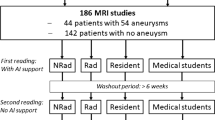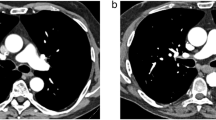Abstract
Purpose
This study was conducted in order to evaluate the image quality of 70 kVp and 25 mL contrast medium (CM) volume for head and neck computed tomographic angiography (CTA) and assess the diagnostic accuracy for arterial stenosis.
Methods
Fifty patients were prospectively divided into two groups randomly: group A (n = 25), 70 kVp with 25 mL CM, and group B (n = 25), 100 kVp with 40 mL CM. CT attenuation values, noise, signal-to-noise ratio (SNR), and contrast-to-noise ratio (CNR) of the shoulder, neck, and cerebral arteries were measured for objective image quality. Subjective image quality of the shoulder and cerebral arteries was also evaluated. For patients undergoing digital subtracted angiography (DSA), diagnostic accuracy of CTA was assessed with DSA as reference standard.
Results
The SNRs of the shoulder, neck, and cerebral arteries in group A were higher than those in group B (P < 0.05). The CNRs of the shoulder and neck arteries in group A were higher than those in group B (P < 0.05). There was no significant difference in subjective image quality of arteries between group A and group B (P > 0.05). The accuracy was noted as 94.0% (156/166) in group A and 97.1% (134/138) in group B for ≥ 50% stenosis. The accuracy of intracranial arterial stenosis was lower than that of extracranial arterial stenosis in group A. The radiation dose of group A was significantly decreased by 56% than that of group B.
Conclusion
Head and neck CTA at 70 kVp using 25 mL CM can obtain diagnostic image quality with lower radiation dose while maintaining high accuracy in detecting the arterial stenosis compared with the 100-kVp and 40-mL CM.





Similar content being viewed by others
Abbreviations
- CM:
-
Contrast medium
- CTA:
-
Computed tomographic angiography
- ADMIRE:
-
Advanced modeled iterative reconstruction
- FBP:
-
Filtered back projection
- SNR:
-
Signal-to-noise ratio
- CNR:
-
Contrast-to-noise ratio
- AA:
-
Aortic arch
- BTA:
-
Brachiocephalic trunk artery
- SA:
-
Subclavian artery
- CCA:
-
Common carotid artery
- VA:
-
Vertebral artery
- MCA:
-
Middle cerebral artery
- BA:
-
Basilar artery
- ED:
-
Effective dose
- DSA:
-
Digital subtracted angiography
- ROI:
-
Region of interest
- MPR:
-
Multiplanar reformation
- MIP:
-
Maximum intensity projections
- SD:
-
Standard deviation
- SCM:
-
Sternocleidomastoideus
- BS:
-
Brain stem
- ACA:
-
Anterior cerebral arteries
- PCA:
-
Posterior cerebral arteries
- SVC:
-
Superior vena cava
- SV:
-
Subclavian vein
- CTDIvol :
-
Volume CT dose index
- DLP:
-
Dose-length product
- ECA:
-
External carotid arteries
- PPV:
-
Positive predictive value
- NPV:
-
Negative predictive value
- CCAbi:
-
Bifurcation of CCA
- IR:
-
Iterative reconstruction
References
Eswaradass P, Appireddy R, Evans J, Tham C, Dey S, Najm M, Menon BK (2016) Imaging in acute stroke. Expert Rev Cardiovasc Ther 14:963–975. doi:10.1080/14779072.2016.1196134
Kim JJ, Dillon WP, Glastonbury CM, Provenzale JM, Wintermark M (2010) Sixty-four-section multidetector CT angiography of carotid arteries: a systematic analysis of image quality and artifacts. AJNR Am J Neuroradiol 31:91–99. doi:10.3174/ajnr.A1768
Hsu CC, Kwan GN, Singh D, Pratap J, Watkins TW (2016) Principles and clinical application of dual-energy computed tomography in the evaluation of cerebrovascular disease. J Clin Imaging Sci 6:27. doi:10.4103/2156-7514.185003
Chen GZ, Zhang LJ, Schoepf UJ, Wichmann JL, Milliken CM, Zhou CS, Qi L, Luo S, Lu GM (2015) Radiation dose and image quality of 70 kVp cerebral CT angiography with optimized sinogram-affirmed iterative reconstruction: comparison with 120 kVp cerebral CT angiography. Eur Radiol 25:1453–1463. doi:10.1007/s00330-014-3533-y
Meyer M, Haubenreisser H, Schoepf UJ et al (2014) Closing in on the K edge: coronary CT angiography at 100, 80, and 70 kV-initial comparison of a second- versus a third-generation dual-source CT system. Radiology 273:373–382. doi:10.1148/radiol.14140244
Cho ES, Chung TS, Ahn SJ, Chong K, Baek JH, Suh SH (2015) Cerebral computed tomography angiography using a 70 kVp protocol: improved vascular enhancement with a reduced volume of contrast medium and radiation dose. Eur Radiol 25:1421–1430. doi:10.1007/s00330-014-3540-z
Chen GZ, Fang XK, Zhou CS, Zhang LJ, Lu GM (2017) Cerebral CT angiography with iterative reconstruction at 70 kVp and 30 mL iodinated contrast agent: initial experience. Eur J Radiol 88:102–108. doi:10.1016/j.ejrad.2016.12.037
Meyer M, Haubenreisser H, Schoepf UJ, Vliegenthart R, Ong MM, Doesch C, Sudarski S, Borggrefe M, Schoenberg SO, Henzler T (2016) Radiation dose levels of retrospectively ECG-gated coronary CT angiography using 70-kVp tube voltage in patients with high or irregular heart rates. Acad Radiol. doi:10.1016/j.acra.2016.08.004
Boos J, Kröpil P, Lanzman RS, Aissa J, Schleich C, Heusch P, Sawicki LM, Antoch G, Thomas C (2016) CT pulmonary angiography: simultaneous low-pitch dual-source acquisition mode with 70 kVp and 40 ml of contrast medium and comparison with high-pitch spiral dual-source acquisition with automated tube potential selection. Br J Radiol 89:20151059
Higashigaito K, Schmid T, Puippe G, Morsbach F, Lachat M, Seifert B, Pfammatter T, Alkadhi H, Husarik DB (2016) CT angiography of the aorta: prospective evaluation of individualized low-volume contrast media protocols. Radiology 280:960–968. doi:10.1148/radiol.2016151982
Fang XK, Ni QQ, Schoepf UJ, Zhou CS, Chen GZ, Luo S, Fuller SR, De Cecco CN, Zhang LJ, Lu GM (2016) Image quality, radiation dose and diagnostic accuracy of 70 kVp whole brain volumetric CT perfusion imaging: a preliminary study. Eur Radiol 26:4184–4193. doi:10.1007/s00330-016-4225-6
Gawlitza J, Haubenreisser H, Meyer M, Hagelstein C, Sudarski S, Schoenberg SO, Henzler T (2016) Comparison of organ-specific-radiation dose levels between 70 kVp perfusion CT and standard tri-phasic liver CT in patients with hepatocellular carcinoma using a Monte-Carlo-simulation-based analysis platform. Eur J Radiol Open 3:95–99. doi:10.1016/j.ejro.2016.04.003
Sabel BO, Buric K, Karara N, Thierfelder KM, Dinkel J, Sommer WH, Meinel FG (2016) High-pitch CT pulmonary angiography in third generation dual-source CT: image quality in an unselected patient population. PLoS One 11:e0146949. doi:10.1371/journal.pone.0146949
Mohan S, Agarwal M, Pukenas B (2016) Computed tomography angiography of the neurovascular circulation. Radiol Clin N Am 54:147–162. doi:10.1016/j.rcl.2015.09.001
Chen Y, Xue H, Jin ZY et al (2013) 128-Slice acceletated-pitch dual energy CT angiography of the head and neck: comparison of different low contrast medium volumes. PLoS One 8:e80939. doi:10.1371/journal.pone.0080939
Barnett HJ, Taylor DW, Eliasziw M et al (1998) Benefit of carotid endarterectomy in patients with symptomatic moderate or severe stenosis. North American Symptomatic Carotid Endarterectomy Trial Collaborators. N Engl J Med 339:1415–1425. doi:10.1056/NEJM199811123392002
Huang J, Degnan AJ, Liu Q, Teng Z, Yue CS, Gillard JH, Lu JP (2012) Comparison of NASCET and WASID criteria for the measurement of intracranial stenosis using digital subtraction and computed tomography angiography of the middle cerebral artery. J Neuroradiol 39:342–345. doi:10.1016/j.neurad.2011.11.005
May MS, Kramer MR, Eller A, Wuest W, Scharf M, Brand M, Saake M, Schmidt B, Uder M, Lell MM (2014) Automated tube voltage adaptation in head and neck computed tomography between 120 and 100 kV: effects on image quality and radiation dose. Neuroradiology 56:797–803. doi:10.1007/s00234-014-1393-4
Scholtz JE, Wichmann JL, Hüsers K, Albrecht MH, Beeres M, Bauer RW, Vogl TJ, Bodelle B (2016) Third-generation dual-source CT of the neck using automated tube voltage adaptation in combination with advanced modeled iterative reconstruction: evaluation of image quality and radiation dose. Eur Radiol 26:2623–2631. doi:10.1007/s00330-015-4099-z
Luo S, Zhang LJ, Meinel FG, Zhou CS, Qi L, McQuiston AD, Schoepf UJ, Lu GM (2014) Low tube voltage and low contrast material volume cerebral CT angiography. Eur Radiol 24:1677–1685. doi:10.1007/s00330-014-3184-z
Scholtz JE, Kaup M, Hüsers K et al (2016) Advanced modeled iterative reconstruction in low-tube-voltage contrast-enhanced neck CT: evaluation of objective and subjective image quality. AJNR Am J Neuroradiol 37:143–150. doi:10.3174/ajnr.A4502
Saade C, El-Merhi F, El-Achkar B, Kerek R, Vogl TJ, Maroun GG, Jamjoom L, Al-Mohiy H, Naffaa L (2016) 256 Slice multi-detector computed tomography thoracic aorta computed tomography angiography: improved luminal opacification using a patient-specific contrast protocol and caudocranial scan acquisition. J Comput Assist Tomogr 40:964–970. doi:10.1097/RCT.0000000000000456
Saade C, Bourne R, Wilkinson M, Evanoff M, Brennan PC (2013) Caudocranial scan direction and patient-specific injection protocols optimize ECG-gated and non-gated thoracic CTA. J Comput Assist Tomogr 37:725–731. doi:10.1097/RCT.0b013e31829e02b9
Author information
Authors and Affiliations
Corresponding author
Ethics declarations
Funding
No funding was received for this study.
Conflict of interest
The authors declare that they have no conflict of interest.
Ethical approval
All procedures performed in the studies involving human participants were in accordance with the ethical standards of the institutional and/or national research committee and with the 1964 Helsinki Declaration and its later amendments or comparable ethical standards.
Informed consent
Informed consent was obtained from all individual participants included in the study.
Rights and permissions
About this article
Cite this article
Chen, Y., Zhang, X., Xue, H. et al. Head and neck angiography at 70 kVp with a third-generation dual-source CT system in patients: comparison with 100 kVp. Neuroradiology 59, 1071–1081 (2017). https://doi.org/10.1007/s00234-017-1901-4
Received:
Accepted:
Published:
Issue Date:
DOI: https://doi.org/10.1007/s00234-017-1901-4




